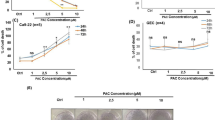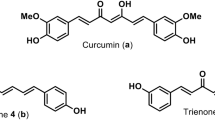Abstract
Effects of diphenyl difluoroketone (EF-24) and curcumin on cell growth and apoptosis induction in KB human oral cancer cells were examined. EF-24 and curcumin inhibited the growth of KB cells in a dose-dependent manner, and the potency of EF-24 was 30 times greater than that of curcumin. Treatment with EF-24 or curcumin resulted in nuclear condensation and fragmentation. EF-24 and curcumin promoted the proteolytic cleavage of procaspases-3, -7, and -9. Activities of caspases-3 and -7 were detected in living KB cells treated with EF-24 or curcumin. These results suggest that EF-24 and curcumin inhibit cell proliferation and induce apoptosis in KB human oral cancer cells, and have potential properties for development of anti oral cancer drug.
Similar content being viewed by others
References
Adams BK, Cai J, Armstrong J, Herold M, Lu YJ, Sun A et al. (2005) EF24, a novel synthetic curcumin analog, induces apoptosis in cancer cells via a redoxdependent mechanism. Anticancer Drugs 16, 263–275.
Adams BK, Ferstl EM, Davis MC, Herold M, Kurtkaya S, Camalier RF et al. (2004) Synthesis and biological evaluation of novel curcumin analogs as anti-cancer and antiangiogenesis agents. Bioorg Med Chem 12, 3871–3883.
Aggarwal BB, Banerjee S, Bharadwaj U, Sung B, Shishodia S, and Sethi G (2007) Curcumin induces the degradation of cyclin E expression through ubiquitin-dependent pathway and up-regulates cyclin-dependent kinase inhibitors p21 and p27 in multiple human tumor cell lines. Biochem Pharmacol 73, 1024–1032.
Ammon HP and Wahl MA (1991) Pharmacol Curcuma longa. Planta Med 57, 1–7.
Anand P, Kunnumakkara AB, Newman RA, and Aggarwal BB (2007) Bioavailability of curcumin: problems and promises. Mol Pharm 4, 807–818.
Bachmeier B, Nerlich AG, Iancu CM, Cilli M, Schleicher E, Vene R et al. (2007) The chemopreventive polyphenol Curcumin prevents hematogenous breast cancer metastases in immunodeficient mice. Cell Physiol Biochem 19, 137–152.
Banerjee M, Tripathi LM, Srivastava VM, Puri A, and Shukla R (2003) Modulation of inflammatory mediators by ibuprofen and curcumin treatment during chronic inflammation in rat. Immunopharmacol Immunotoxicol 25, 213–224.
Cheng YL, Lee SC, Lin SZ, Chang WL, Chen YL, Tsai NM et al. (2005) Anti-proliferative activity of Bupleurum scrozonerifolium in A549 human lung cancer cells in vitro and in vivo. Cancer Lett 222, 183–193.
Choi HS, Cho MC, Lee HG, and Yoon DY (2010) Indole-3-carbinol induces apoptosis through p53 and activation of caspase-8 pathway in lung cancer A549 cells. Food Chem Toxicol 48, 883–890.
Christou L, Hatzimichael E, Chaidos A, Tsiara S, and Bourantas KL (2001) Treatment of plasma cell leukemia with vincristine, liposomal doxorubicin and dexamethasone. Eur J Haematol 67, 51–53.
Cohen GM (1997) Caspases: The executioners of apoptosis. Biochem J 326, 1–16.
Datta R, Kojima H, Yoshida K, and Kufe D (1997) Caspase-3-mediated cleavage of protein kinase C theta in induction of apoptosis. J Biol Chem 272, 20317–20320.
Goel A, Kunnumakkara AB, and Aggarwal BB (2008) Curcumin as ‘Curecumin’: from kitchen to clinic. Biochem Pharmacol 75, 787–809.
Green DR and Reed JC (1998) Mitochondria and apoptosis. Science 281, 1309–1312.
Hauser PJ, Han Z, Sindhwani P, and Hurst RE (2007) Sensitivity of bladder cancer cells to curcumin and its derivatives depends on the extracellular matrix. Anticancer Res 27, 737–740.
Hengartner MO (2000) The biochemistry of apoptosis. Nature 407, 770–776.
Hoshino T, Hara A, Inoue M, Honda J, Imai Y, Oizumi K et al. (1997) Flow cytometric measurement of NK cell cytotoxicity. J Clin Lab Immunol 36, 39–43.
Hu W and Kavanagh JJ (2003) Anticancer therapy targeting the apoptotic pathway. Lancet Oncol 4, 721–729.
Kaufmann SH and Earnshaw WC (2000) Induction of apoptosis by cancer chemotherapy. Exp Cell Res 256, 42–49.
Kaufmann SH and Hengartner MO (2001) Programmed cell death: Alive and well in the new millennium. Trends Cell Biol 11, 526–534.
Kim CS, Cho SH, Chun HS, Lee SY, Endou H, Kanai Y et al. (2008) BCH, an inhibitor of system L amino acid transporters, induces apoptosis in cancer cells. Biol Pharm Bull 31, 1096–1100.
Liu X, Zou H, Slaughter C, and Wang X (1997) DFF, a heterodimeric protein that functions downstream of caspase-3 to trigger DNA fragmentation during apoptosis. Cell 89, 175–184.
Miquel J, Bernd A, Sempere JM, Diaz-Alperi J, and Ramirez A (2002) The curcuma antioxidants: pharmacological effects and prospects for future clinical use. A review. Arch Gerontol Geriatr 34, 37–46.
Mukherjee AK, Basu S, Sarkar N, and Ghosh AC (2001) Advances in cancer therapy with plant based natural products. Curr Med Chem 8, 1467–1486.
Mukhopadhyay A, Bueso-Ramos C, Chatterjee D, Pantazis P, and Aggarwal BB (2001) Curcumin downregulates cell survival mechanisms in human prostate cancer cell lines. Oncogene 20, 7597–7609.
Notani PN (2000) Epidemiology and prevention of head and neck cancer: A Global View. In Contemporary Issues in Oral Cancer, Saranath D (ed.), pp. 1–29, Oxford University Press, UK.
Park DI, Lee JH, Moon SK, Kim CH, Lee YT, Cheong J et al. (2005) Induction of apoptosis and inhibition of telomerase activity by aqueous extract from Platycodon grandiforum in human lung carcinama cells. Pharmacol Res 51, 437–443.
Paschka AG, Butler R, and Young CYF (1998) Induction of apoptosis in prostate cancer cell lines by the green tea component, (-)-epigallocatechin-3-gallate. Cancer Lett 130, 1–7.
Pezutto JM (1997) Plant-derived anticancer agents. Biochem Pharmacol 53, 121–133.
Reed JC (2001) Apoptosis-regulating proteins as targets for drug discovery. Trends Mol Med 7, 314–319.
Sahu RP, Batral S, and Srivastava SK (2009) Activation of ATM/Chk1 by curcumin causes cell cycle arrest and apoptosis in human pancreatic cancer cells. Br J Cancer 100, 1425–1433.
Shankar S and Srivastava RK (2007) Involvement of Bcl-2 family members, phosphatidylinositol 30-kinase/AKT and mitochondrial p53 in curcumin (diferulolylmethane)-induced apoptosis in prostate cancer. Int J Oncol 30, 905–918.
Smets LA (1994) Programmed cell death (apoptosis) and response to anticancer drugs. Anti-Cancer Drug 5, 3–9.
Tan ML, Suaiman SF, Najimuddin N, Smian MR, and Tengku Muhammad TS (2005) Methanolic extract of Pereskia bleo (Kunth) DC. (Cactaceae) induces apoptosis in breast carcinoma, T47-D cell line. J Ethnopharmacol 96, 287–294.
Tan X, Sidell N, Mancini A, Huang RP, Wang S, Horowitz IR et al. (2010) Multiple anticancer activities of EF24, a novel curcumin analog, on human ovarian carcinoma cells. Reprod Sci 17, 931–940.
Tian Z, Chen S, Zhang Y, Huang M, Shi L, Huang F et al. (2006) The cytotoxicity of naturally occurring styryl lactones. Phytomedicine 13, 181–186.
Todd R, Donoff RB, and Wong DT (1997) The molecular biology of oral carcinogenesis: toward a tumor progression model. J Oral Maxillofac Surg 55, 613–623.
van Poppel G and van den Berg H (1997) Vitamins and cancer. Cancer Lett 114, 195–202.
Wahl H, Tan L, Griffith K, Choi M, and Liu JR (2007) Curcumin enhances Apo2L/TRAIL-induced apoptosis in chemoresistant ovarian cancer cells. Gynecol Oncol 105, 104–112.
Author information
Authors and Affiliations
Corresponding author
Additional information
H. S. Jeon and M. H. Jo contributed equally.
Rights and permissions
About this article
Cite this article
Jeon, HS., Jo, MH., Kim, HJ. et al. Anticancer activities of diphenyl difluoroketone, a novel curcumin analog, on KB human oral cancer cells. J Korean Soc Appl Biol Chem 55, 451–456 (2012). https://doi.org/10.1007/s13765-012-1168-8
Received:
Accepted:
Published:
Issue Date:
DOI: https://doi.org/10.1007/s13765-012-1168-8




